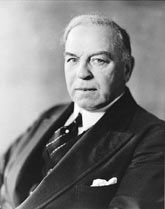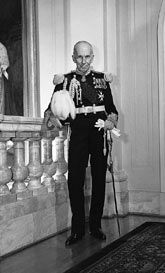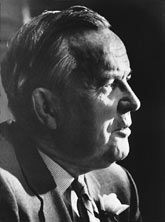The politician
Louis S. St. Laurent National Historic Site
© Parks Canada
In November 1941, the Honourable Ernest Lapointe, senior assistant to Prime Minister Mackenzie King, died in Quebec. The position of Justice Minister was then entrusted to Louis S. St-Laurent, who accepted it, even though he was not really interested in becoming politically involved. He said that he only took the position out of a sense of duty and would not remain in this post beyond the end of the war.
 William Lyon Mackenzie King
William Lyon Mackenzie King© National Archives of Canada / C-13225
During this period, the Minister of Justice was the right hand man of the Prime Minister. This meant that St-Laurent was taking care of major files: internal security via the RCMP (for which he was responsible), federal-provincial relations, the debate over the national flag, family allowances and conscription . Throughout this period dominated by the concerns of war, St-Laurent remained faithful to his leader. Since he was responsible for tabling often controversial and unpopular bills, St-Laurent found himself learning about political life the hard way.
Once the war was over, he asked to be released from his political commitment in order to go back to his law office. But the Prime Minister refused. King needed people to help him with post-war reconstruction . Some months later, therefore, St-Laurent found himself Secretary of State for External Affairs .
 The right Honourable Vincent Massey, the first Governor General of Canadian descent
The right Honourable Vincent Massey, the first Governor General of Canadian descent© National Archives of Canada / PA-144172
This appointment was a major step in opening up Canada to foreign politics. His strategy was to create a new image of Canada throughout the world, whether in the UN, NATO or inside the Commonwealth. Meanwhile, the Gouzenko affair broke and Canadians learned with astonishment of the existence of a major Soviet spy ring in Ottawa.
Following the resignation of Mackenzie King, St-Laurent became leader of the Federal Liberal Party. On November 15, 1948, he became Prime Minister, and the following year, he called an election and led his party to victory .
St-Laurent, who was in power for two consecutive mandates, has many accomplishments to his credit. He promoted national autonomy by securing the appointment of the Right Honourable Vincent Massey as the first Governor General of Canadian descent. It was also during his first mandate that, on March 31, 1949, Newfoundland became the tenth Canadian province .
 Family allowances cheque, 1954
Family allowances cheque, 1954© Parks Canada
The Canadian government also became involved in major projects such as the Trans-Canada Highway and the St. Lawrence Seaway. At the same time, it developed its social policy : family allowances, unemployment insurance, old-age pensions, financial support for universities and the creation of the Arts Council.
Internationally, thanks to St-Laurent, Canada gradually affirmed its sovereignty. NATO became a reality and, under the auspices of the United Nations, the Canadian government sent troops to Korea.
 Lester Bowles Pearson
Lester Bowles Pearson© National Archives of Canada / D.Cameron / PA-57932
After the difficulties of 1956, involving the Suez crisis and the gas pipeline controversy, St-Laurent was defeated by John Diefenbaker in 1957. He then retired from politics, at the age of 75, and once more took charge of his law office. In January 1958, he was succeeded as leader of the Liberal Party by Lester B. Pearson.
In 1967, St-Laurent became a Companion of the Order of Canada. This honorary distinction, presented to him by the Governor General Roland Michener, is the greatest mark of appreciation that Canada can give to one of its citizens.
Louis Stephen St-Laurent died on July 25, 1973, aged 91. After a State funeral in Quebec, his body was taken to Compton for burial.
Related links
- Date modified :